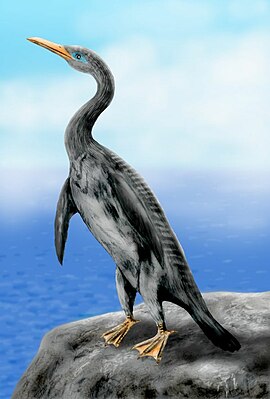Plotopteridae
| Plotopteridae | ||||||||||
|---|---|---|---|---|---|---|---|---|---|---|

Copepteryx , graphic reconstruction |
||||||||||
| Temporal occurrence | ||||||||||
| Upper Eocene to Upper Oligocene | ||||||||||
| 37 to 25 million years | ||||||||||
| Locations | ||||||||||
|
||||||||||
| Systematics | ||||||||||
|
||||||||||
| Scientific name | ||||||||||
| Plotopteridae | ||||||||||
| Howard , 1969 |
The Plotopteridae are an extinct family of flightless seabirds that lived on the shores of the northern Pacific from the Middle Eocene to the Early Miocene . In the northern Pacific they occupied the ecological niche of the penguins, which only live in the southern oceans, and had developed convergent to them. Family fossils have been found in California, Oregon , Washington , British Columbia, and Japan.
features
The birds were similar to the recent penguins, but belong to the Suliformes with today's gannets , darter and cormorants . Their beak resembled that of the penguins with the slit-shaped nostrils. The chest, shoulder girdle and the short, fin-like wings were built like those of the penguins and were probably used for propulsion when swimming. The largest known diving birds belonged to the Plotopteridae; the largest species measured more than two meters from beak to tip of its tail.
Discovery story
The family was described by Hildegarde Howard in 1969 after the discovery of an upper section of a left coracoid in the San Joaquin Valley , California. The fossil was described as Plotopterum joaquinensis and dates from the early Miocene. Precise knowledge of the anatomy of birds was gained from new discoveries from the late Oligocene and early Miocene from Japan and Washington.
Way of life
The Plotopteridae probably also lived far from the coast in the open ocean. The fossil remains of Phocavis maritimus , the oldest species, were found in Oregon in sediments deposited at a depth of 500 to 1000 meters. They became extinct along with large species of penguins at the end of the early Miocene. The reason is believed to be competition with the newly evolved seals and porpoises . Both taxa were undergoing rapid adaptive radiation at this time .
Genera
swell
- Alan Feduccia : The Origin and Evolution of the Birds. 2nd ed., Yale University Press, New Haven / London 1999, ISBN 0300078617 .
Individual evidence
- ↑ a b c Gerald Mayr, James L. Goedert, Vanesa L. De Pietri, R. Paul Scofield: Comparative osteology of the penguin-like mid-Cenozoic Plotopteridae and the earliest true fossil penguins, with comments on the origins of wing-propelled diving. Journal of Zoological Systematics and Evolutionary Research, June, 2020; doi: 10.1111 / jzs.12400
- ^ Howard, H. (1969): A new avian fossil from Kern County, California. Condor 71: 68-69. PDF
- ↑ Storrs L. Olson, Yoshikazu Hasegawa (1979): Fossil Counterparts of Giant Penguins from the North Pacific. Science November 9, 1979: Vol. 206. No. 4419, pages 688-689 doi : 10.1126 / science.206.4419.688